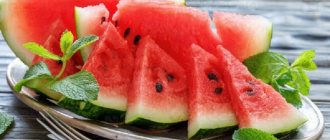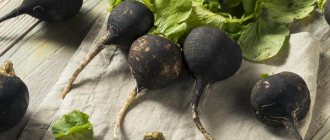Watermelon, which we are used to enjoying at the height of the melon season, will become a real highlight of the table in the winter season.
The only problem is that preserving sunberries for such a long time is not so easy. But probably! We will now talk about how to preserve watermelon until the New Year so that it does not lose its taste and aroma. Watermelon will be a real highlight of the table in the winter season
Of course, nowadays you won’t surprise anyone with fresh fruit on the New Year’s or Christmas table. You won’t find anything on sale: bananas and oranges, kiwis and pineapples, as well as grapes, persimmons and even fresh strawberries. But this is how a person is designed, that most of all he wants exactly what is practically inaccessible (due to a number of reasons) right now, at the moment. In the winter season, watermelon can easily be considered one of these rarities: buying is not a problem, but the price and quality, to put it mildly, are not encouraging. Naturally, a practical solution arises - try to preserve it through your own efforts.
There are many ways and tips on how to preserve watermelon until the New Year. Some of them are practical and effective, others are quite unusual. But let’s not rush, let’s talk about everything in order: about methods, conditions, requirements and secrets.
There are many ways and tips on how to preserve watermelon
Svetlana talked about one of the storage methods tested in practice in the article How to Preserve a Watermelon until Christmas. The method is very simple, but very effective. The author of the post Watermelon for the New Year also shares his personal experience.
Ads by
Which watermelons are suitable for long-term storage?
Choosing the right fruit is only half the battle. Important characteristics of the berry are variety, degree of ripeness, condition and weight.
The best varieties
Late-ripening varieties are suitable for long-term storage. Their ripening period is from 95 to 110 days after emergence. Such fruits go on sale from the end of August, have a strong and thick peel, and ripen better.
The most common varieties:
- Kholodok is popular in Russia. Large fruits weighing 15–25 kg ripen in 100–110 days. Light green, with distinct dark stripes, watermelons have the shape of a slightly elongated ellipse. They are stored for up to three months.
- Icarus is a mid-late variety, suitable for long-term storage. Fruits weighing 13–15 kg tolerate transportation well and last up to five months. Watermelons are dark green with faint black stripes.
- Bush 334 is late-ripening, has relatively small fruits weighing up to 8 kg, light green in color with dark stripes. The peel is durable and can withstand transportation. Shelf life - up to three months.
- Bogatyrsky - despite this name, watermelons weigh no more than 8 kg. The color is light green with dark stripes. The peel is thin, the flesh is dark red. The shelf life of the fruit is up to three months.
How to choose the right fruit
For long-term storage, watermelons are collected by hand on a soft bedding so that they are not injured and do not turn sour.
When buying berries, pay attention to a number of signs:
- dry tail, distinct yellow or orange spot;
- the peel is without external damage or holes (small brownish stripes are traces of grass and insects);
- average weight: “giants” of 15–20 kg are damaged under the pressure of their own weight and take up a lot of space;
- the surface is equally hard and dry in all places, without dents or soft spots.
The fruits should be neatly laid out on soft litter. When piled up, they quickly turn sour.
Important! Unripe berries are not suitable: they do not ripen well outside the bush.
In stores, watermelons are often placed in carts or boxes with metal bars. Under the pressure of their own weight, such fruits are quickly damaged. Subtle marks from the mesh will cause rapid spoilage of supplies.
Recommendations
According to reviews from experienced melon growers, it is recommended to adhere to the following rules for long-term storage:
1. Use only ripe watermelons. After picking, they will not ripen further, and unripe fruits are stored less and do not have a perfect taste;
2. When storing, berries should not touch each other, other vegetables or fruits;
3. Do not place watermelons on hard and hard surfaces. It is necessary to add straw, sawdust, sand, grain;
4. Fruits should be constantly turned over to ensure their integrity is maintained.
With the right choice and following all the rules, the berries are stored without loss of taste for 3-4 months.
How to keep a watermelon in the cellar until the New Year
The cellar is one of the most suitable places for melons. Thanks to optimal (constant) conditions and humidity levels, the berries here do not spoil for a long time. We'll tell you how best to store fruits in such a room.
Preparation
The underground floor has been prepared since the fall: they check the ventilation system, remove areas of mold and dampness, and destroy parasites.
To do this:
- Cleaning ventilation pipes : the grille on the openings will close the passage for insects and rodents.
- Preparation of walls : large cracks are sealed with cement, mold areas are treated with special compounds, and painted with lime.
- Drying the room: in dry weather, the basement is left open for several days. Shelves, drawers, and racks are temporarily taken outside.
- Disinfection with a smoke bomb: this will destroy pockets of mold, rot, and repel rodents and insects. They burn a sulfur bomb at the onset of the first frost, when rodents begin to actively seek warm shelters.
Optimal conditions
The cellar is well suited for storing melons: watermelons require a constant temperature of +2...+4°C and a humidity of 60–80%.
Important! The berries are not laid out on a hard surface: under the pressure of its own weight, the bark is gradually pressed down, and the fermentation process begins. Straw, sand, moss are used as bedding, or fruits are hung in a net.
They leave fruits for the winter not only in the basement, but also in the apartment.
The most suitable places for this:
- pantry;
- bathroom;
- mezzanine or closet;
- glazed balcony or loggia.
Fruits are not placed near heating devices. Choose a dark place with a constant temperature. When stored on the balcony in severe frosts, watermelons are removed into the room.
Nuances
When storing several fruits, they are isolated from each other: if one of them begins to deteriorate or releases juice, the rot will spread to other berries. The condition of the stock is checked periodically - if wet soft spots, cracks, or plaque appear, the watermelons are removed from the storage area.
Sometimes the peel is treated with various compounds to extend the shelf life of the product:
- Clay - the peel is coated with a liquid solution, allowed to dry, then a second layer is applied. The thickness of the coating is 0.5–1 cm. The processed berries are stored hanging or on a litter.
- Wax or paraffin - The substance is melted and the surface of the berry is treated with it. Then it is placed on a soft mat or suspended. Wax and paraffin protect vegetables and fruits from rot and mold.
Processing the peel has a significant drawback: the additional peel makes it difficult to control the condition of the fruit.
It is not necessary to keep the berries whole. The diced pulp is placed in the freezer. Instead of bags, use plastic containers to prevent the pieces from being crushed and losing their juice. Such preparations are suitable for making desserts.
How long can you store a cut watermelon?
Unlike whole berries, which will last for weeks or even months, cut fruits are suitable for consumption within a very short period of time: they can be stored from several hours to 1.5-2 days.
Watermelon peel reliably protects the pulp inside from the penetration of bacteria and other unwanted microorganisms. In the absence of such protection, sweet pulp becomes an ideal environment for the growth and reproduction of pathogenic microflora. A cut watermelon left in the open air becomes not so much tasteless as it becomes dangerous, as it can cause food poisoning.
Storage methods in the basement
Among the various options for storing watermelons in the basement, choose the most affordable one, taking into account the available materials. Typically straw, sand, grain, moss or ash are used. Depending on the contents of the cellar, you will need shelves, separate drawers and boxes.
On the racks
Shelves must be dry and free of mold. Any soft material is laid out on them: straw, rags, crumpled paper. Watermelons are placed separately from each other at a short distance.
Important! Periodically check the condition of the fruits and turn them over.
In limbo
It is convenient to keep berries in string bags and mesh bags for vegetables. The fruits are coated with clay, wax or wrapped in fabric with a natural composition (cotton or wool). Hang them so that they do not touch the walls or shelves.
Good to know. An old pillowcase used as a bag is suitable for wrapping.
In sand and ash
Sand is one of the most accessible materials. It is taken clean and dry, without insects and grass residues. To clean, sift.
A 5–10 cm layer of sand is poured onto the bottom of the box. A watermelon is placed in the middle and completely covered. Wood ash is used instead of sand. It has antiseptic properties and protects well from mold and pests.
In the straw
Dry straw is placed in a box or on shelves. A watermelon is placed on the litter and covered with dry grass on all sides. Periodically, the hay is turned and the fruit is turned over.
In liquid clay
To store the berries, liquid clay is diluted in a barrel or bucket. The watermelon is placed so that it is completely submerged. The container is closed so that the fruit does not float.
In the moss
If there is a forest nearby, moss is dug out from it. It absorbs moisture well, protecting the fruit from spoilage. The material is collected in dry weather and then thoroughly dried in the sun. The watermelon is completely covered with moss and stored in a box or hanging.
Signs of a ripe watermelon
It is advisable to buy one fruit for testing. This will allow for a more thorough check:
— If the pulp has noticeable yellow tints, it means that chemicals were used during cultivation;
— The pulp should turn cloudy upon contact with water. If it turns bright red, then there are nitrates;
— You shouldn’t store very crumbly pulp until the holidays;
— If there are cracks, white or brown spots on the peel, then you should not buy a watermelon. The peel must be intact, otherwise it will not be possible to preserve the fruit;
— It is worth choosing a berry with a dry tail or stalk and shiny skin;
— There is no need to choose large watermelons, as they will rot faster. Weight should be no more than 5 kg;
— It is important to buy ripe fruits. If the berry is unripe, it will remain green. An overripe watermelon will soon spoil;
— Berries should be picked in dry weather, as high humidity increases the likelihood of rotting;
— Late varieties are used for planting, so it is advisable to start harvesting in early autumn.
Important: Selecting a batch of fruits for storage for the winter is a labor-intensive and responsible process. Therefore, first you should buy 5-6 fruits; there is no point in purchasing a large batch at once.
Reviews
Many people share their experience of successfully preserving the fruit until winter.
Svetlana: “Watermelon is the highlight of my New Year’s table. I usually buy fruit for the winter at the end of September. The main thing is to choose a whole and strong one. I coat it with alabaster mixture. I dilute the solution to the consistency of sour cream. After drying, the surface should be smooth, without cracks. I hang the processed berries in a net in the basement.”
Sergey: “I always saved a watermelon for my son’s birthday in January. This has become our home tradition, and now that the child has grown up, he still comes to us for a treat. We don’t live in a private house, so we leave the watermelon on the mezzanine in a box with crumpled paper. Sometimes I coat it with wax. To do this, I melt 10 regular candles in a bowl. I hold the fruit suspended, dip it a little and turn it on each side. The wax sets immediately, especially if the berry has been in the refrigerator.”
Common Mistakes
The main mistake is considered to be neglecting the rules listed above. But there are several other oversights that harm the process:
— Using glossy magazines for packaging . There is no need to do this, since printing uses chemical dyes that end up in the fruit;
— Canning in paraffin . It is a petroleum product, so it should not come into contact with food.
Where to store a whole watermelon for the winter
To preserve whole berries until the winter months, you need to choose a place that will maintain the conditions most suitable for them. Deviation from the recommended indicators will not allow you to save berries for the winter.
So, when the temperature rises, the pulp will begin to deteriorate faster, and when it drops below 0 degrees, it will turn into ice. Too low humidity can cause melons to dry out, and the presence of excess moisture will cause premature rotting.
Before choosing a room where the berries will be stored, it is necessary to assess the possibility of meeting all requirements.
Conditions and optimal storage temperature
To preserve fresh watermelon until the New Year at home, you need to find a suitable room. You can’t keep potatoes, beets, or pumpkins nearby. Even short-term proximity to grapes, kiwi, apples, melons, pineapple and other fruits is undesirable.
Storage requirements:
- lack of light;
- temperature up to +5°C;
- air circulation;
- humidity from 60 to 80%.
These requirements do not apply to traditional methods that use coating, covering the crust with clay or wax.
In the fall, basements and cellars are cleaned of debris, husks, and remnants of last year's harvest. It is advisable to treat with vitriol and whitewash the walls. If necessary, sprinkle shelves and drawers with dry lime.
Questions and answers
How to store watermelon in a container with ashes?
Ashes are poured into a dry wooden container, in a thick layer up to 7 cm. Watermelons are placed on top, completely covered with ash, then the container is tightly closed with a lid and put in a cool place.
How long does watermelon last outdoors?
Watermelon without defects can be stored at room temperature for a month.
What places other than the cellar are suitable for storage?
Suitable places for storing watermelon in a private home are a summer kitchen, garage, attic, basement. The apartment has a glazed loggia, a balcony, and a storage room.
Do I need to wash a watermelon before storing it?
It is not recommended to wash berries before storing. But in this case, it all depends on the storage method: for example, if the berry will be in the refrigerator, next to the food, then it is better to wash it thoroughly and dry it.
How to choose watermelon for long-term storage?
An ideal fruit for long-term storage has the following characteristics:
- glossy top layer;
— medium sizes (up to 5 kg);
- clearly defined pattern;
- dry stalk;
- dull sound when tapping;
- a small yellow spot on the side.
Expert advice
Expert opinion
Kuznetsov Sergey Ivanovich
Expert on melons and melons
- The most suitable time to buy watermelon for long-term storage is the end of September.
- You should not buy berries that are sold on the side of the roads. Harmful substances from exhaust gases enter the microcracks of the watermelon, causing not only rapid rotting of the product, but also negative health consequences.
- When purchasing, be sure to ask the seller for a certificate and a health book.
- For long-term storage, it is better to choose fruits weighing 4-5 kg.
- The surface of the fruit should be glossy, with clear stripes. There should be no defects on the peel.
- A spot forms where the fruit comes into contact with the ground. It should be yellow. The presence of a white spot on a watermelon indicates the presence of nitrates.
- It is better to choose ripe fruits. You can check this by lightly pressing the tip of your nail on the peel: if you cannot pierce the surface, then the watermelon is ripe.
- If watermelons are grown on your own plot, then harvesting should be done as carefully as possible: falls on hard surfaces and other mechanical damage should not be allowed.










